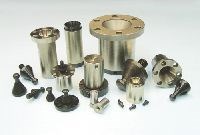Quick-Change Devices Reduce Setup Time
A line of quick-change devices has been developed that serves as a replacement for traditional nuts and bolts and can reduce setup time.
A line of quick-change devices has been developed that serves as a replacement for traditional nuts and bolts and can reduce setup time.
Segen quick-change devices from Tooling Tech Group (Fort Loramie, OH)—a group of five business units that provide the state-of-the-art technology, engineering, tooling and production items to a wide variety of OEMs, Tier I and II automotive suppliers and contract molders—consist of a steel cylinder lock and a corresponding knob. The cylinder lock, designed to receive and mate with a conical male knob, locates and positions the knob to within 0.0002” with an incredible holding force of up to 25,000 lbs. per device depending on cylinder specifications.
“Positively locked in a static state, the cylinder lock actuates when air pressure is applied to release or receive the knob,” notes Jeff Barker, Sales Director, of Tooling Tech Group. “The cylinder locks stay mechanically locked until pneumatic pressure is applied to automatically release them. This assures a secure, fail-safe hold, even if pneumatic pressure is lost.”
Applications
An enhanced version of the product uses an internal sensor to offer the machine operator a visual means of identifying that the mechanism is positively locked or unlocked—thereby improving the safety, reliability, efficiency and overall effectiveness of the system.
The PD500 Mega Cylinder, the largest version yet, will help facilitate record changeover times of some of the largest tools, fixtures, molds and dies for an extensive range of industries. Weighing in at 11 pounds, each mega cylinder will hold its mating 2-pound knob in an accurate and repeatable home position with 25,000 pounds of static holding force, according to Barker. “Like its smaller siblings before, the new Mega Cylinder is engineered for long life with a corrosion resistant finish and an operational temperature range between –65 to +300 degrees Fahrenheit,” Barker says. “The high-strength steel knobs will withstand greater sheer loads, accelerating the changeovers of larger and/or inverted and vertically positioned tools, molds and dies.”
Advantages
According to Barker, a typical platen, mold or tool setup that traditionally takes hours to change out can now be changed in a matter of minutes. “The devices are reducing the production costs of tool making, machine builders, manufacturers and end users in plastics, robotics, appliances, medical equipment, automation, windows, aerospace, welding, automotive, electronics, metals and other markets by making old-style bolts and dowels obsolete,” Barker explains. “The quick-change cylinders are ideal for precisely and quickly locating tools, jigs or fixtures—making changeovers and setups simple, safe and secure.”
Related Content
-
Machine Hammer Peening Automates Mold Polishing
A polishing automation solution eliminates hand work, accelerates milling operations and controls surface geometries.
-
Fundamentals of Designing the Optimal Cooling System
The right mold components can help improve mold cooling and thereby produce higher-quality parts.
-
6 Ways to Optimize High-Feed Milling
High-feed milling can significantly outweigh potential reliability challenges. Consider these six strategies in order to make high-feed milling successful for your business.















